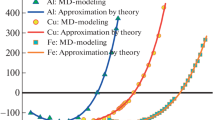Abstract
Titanium dissolution in the aluminum melt and synthesis of an intermetallic compound at constant temperature and pressure are numerically simulated by the molecular dynamics method. Owing to titanium dissolution, the TiAl3 intermetallic compound is formed near the interface between the titanium crystal and aluminum melt. Based on the theory of weak solutions, a mathematical model of titanium dissolution in the aluminum melt is constructed. Dependences of the diffusion coefficient, equilibrium concentration of titanium, and dissolution rate on temperature are obtained.
Similar content being viewed by others
References
L. Xu, Y. L. Cui, Y. L. Hao, and R. Yang, “Growth of Intermetallic Layer in Multi-Laminated Ti/Al Diffusion Couples,” Material Sci. Engng. A 435/436, 638–647 (2006).
I. A. Bataev, A. A. Bataev, V. I. Mali, et al., “Nucleation and Growth of Titanium Aluminide in an Explosion— Welded Laminate Composite,” Phys. Metals Metallography 113 (10), 947–956 (2012).
S. P. Kiselev and N. S. Ryashin, “Ti–Al Intermetallic Compounds Synthesis in Coatings Deposited by Cold Spraying,” AIP Conf. Proc. 1770, 030093-1–030093-4 (2016).
S. P. Kiselev, N. S. Ryashin, and A. A. Polukhin, “Diffusion Processes in Annealing Aluminum Coatings Deposited by Cold Gas-Dynamic Spraying on Titanium,” in Abstracts 3rd Intern. Conf. “Nonisothermal Phenomena and Processes: from the Thermal Explosion Theory to Structural Macrokinetics,” Chernogolovka, November 28–29, 2016 (METR i K, Chernogolovka, 2016), pp. 105–106.
J. Krai, M. Ferdinandy, and P. Diko, “Formation of TiAl3 Layer on Titanium Alloys,” Material Sci. Engng. A 140, 749–785 (1991).
R. Khoshhal, M. Soltaniech, and M. Mirjalili, “Formation and Growth of Titanium Aluminide Layer at the Surface of Titanium Sheets Immersed in Molten Aluminum,” Iranian J. Materials Sci. Engng. 7 (1), 24–31 (2010).
M. Sujata, S. Bhargava, and S. Sangal, “Microstructurial Features of TiAl3 Base Compounds Formed by Reaction Synthesis,” Materials Design 32 (1), 207–216 (2011).
L. M. Gurevich, “Mechanisms of Structure Formation due to Titanium Interaction with the Aluminum Melt,” Izv. Volgogr. Gos. Univ., Ser. Probl. Mater. Svarki Prochnosti v Mashinostr. 7 (6), 6–13 (2013).
K. B. Koshelev, “Investigation of the Structure Formation and Self-Heating Processes in a Binary Ti–Al Powder Mixture in the Regime of a Static Thermal Explosion on the Basis of the Diagram of State,” Izv. Tomsk. Politekh. Univ. 312 (2), 44–47 (2008).
S. P. Kiselev, “Numerical Simulation of Synthesis Kinetics of the Ti–Al Intermetallic Compound by the Molecular Dynamics Method,” Fiz. Mezomekh. 19 (3), 47–57 (2016).
S. P. Kiselev, “Simulation of Crystallization of the Ti–Al Nanoparticle by the Molecular Dynamics Method,” Dokl. Akad. Nauk 466 (4), 406–408 (2016).
R. R. Zope and Y. Mishin, “Interatomic Potentials for Atomistic Simulations of the Ti–Al System,” Phys. Rev. B 68, 024102-1–024102-14 (2003).
S. L. Nose, “Unified Formulation of the Constant Temperature Molecular Dynamics Methods,” J. Chem. Phys. 81, 511–519 (1984).
S. J. Plimpton, “Fast Parallel Algorithms for Short-Range Molecular Dynamics,” J. Comput. Phys. 117, 1–19 (1995).
S. P. Kiselev, “Method of Molecular Dynamics in Mechanics of Deformable Solids,” Prikl. Mekh. Tekh. Fiz. 55 (3), 113–139 (2014) [J. Appl. Mech. Tech. Phys. 55 (3), 470–493 (2014)].
L. D. Landau and E. M. Lifshits, Statistical Physics. Pt 1 (Nauka, Moscow, 1976) [in Russian].
Author information
Authors and Affiliations
Corresponding author
Additional information
Original Russian Text © S.P. Kiselev, V.P. Kiselev.
Translated from Prikladnaya Mekhanika i Tekhnicheskaya Fizika, Vol. 58, No. 5, pp. 158–166, September–October, 2017.
Rights and permissions
About this article
Cite this article
Kiselev, S.P., Kiselev, V.P. Numerical simulation of titanium dissolution in the aluminum melt and synthesis of an intermetallic compound. J Appl Mech Tech Phy 58, 895–903 (2017). https://doi.org/10.1134/S0021894417050169
Received:
Published:
Issue Date:
DOI: https://doi.org/10.1134/S0021894417050169




